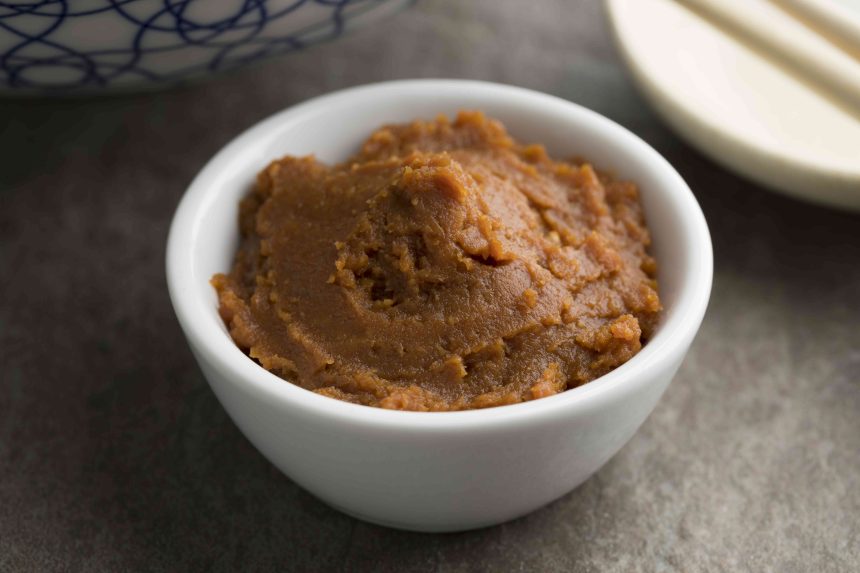If you enjoy Japanese cuisine, you’ve probably had your fair share of miso, likely in the form of soup. The thick paste is distinctively complex, as it manages to taste sweet, salty, nutty, earthy, and umami all at once. If you’re not already using miso in your cooking, it’s time to add it to your rotation. The condiment can elevate everything from single ingredients (like butter) to homemade dishes (like stew). Learn all about miso from Japanese food experts, including the different types of miso and how to store, buy, and use this unique ingredient.
- Sonoko Sakai, chef, cooking teacher, and author of Japanese Home Cooking
- Masaharu Morimoto, chef/owner of Morimoto Restaurants, chef and judge of Morimoto’s Sushi Master on Roku Channel
- Takahiro Terada, head chef at Tsuta, a ramen restaurant in Brooklyn, N.Y.
What Is Miso?
Miso, a fermented soybean paste, is a culinary staple in Japan, says Sonoko Sakai, chef, cooking teacher, and author of Japanese Home Cooking. It’s made using just four ingredients: cooked soybeans, grains (typically rice), salt, and koji mold, a type of fungus scientifically known as Aspergillus oryzae. The koji works by producing enzymes, which break down proteins and starches. This results in fermentation, which produces alcohols that are responsible for the rich flavor of miso.
As with other fermented foods, miso is a source of probiotics, or live “good” bacteria that benefit the gut. The paste is also rich in protein, as soybeans are one of the top sources of plant-based protein.
Types of Miso
According to Sakai, the color, flavor, and texture of miso can vary greatly, depending on the ratio of soybeans vs. grains; it can also be made entirely of soybeans or grains. Other factors that affect the characteristics of miso include the percentage of koji, type of grains, amount of added salt, total fermentation time (which can range between six months to three years or more), and addition of sweetener, if any at all. With all those variations, it’s not surprising that miso can boast a variety of flavors, ranging from sweet honey to deep and smoky caramel.
In general, miso can be categorized into three types:
- White miso: Also known as shiro miso, white miso is made with more rice than soybeans. It uses less salt than other varieties, so it’s sweeter and less intense, says Takahiro Terada, head chef at Tsuta, a ramen restaurant in Brooklyn.
- Yellow miso: Yellow miso is also called shinsho miso. Compared to white miso, it uses barley and more soybeans, and it’s fermented for a longer time. This gives it a saltier flavor, though it’s not as salty as red miso, says Terada.
- Red miso: Made with a higher percentage of soybeans vs. grains, red miso is fermented for a long time, giving it a more intense flavor and darker color, says Terada. It’s saltier than white or yellow varieties. It’s also known as aka miso.
Other types of miso include mixed miso, or awase miso, which is made by combining white and red miso, says Terada. Miso can also be made with 100 percent soybeans to produce hatcho miso, which is very dark in color, says Sakai.
How to Buy Miso
Miso is available at most grocery stores, typically in the Asian section or in the refrigerated section near the tofu. However, the options might be limited, so it’s best to visit a specialty Asian or Japanese supermarket if you want more variety. In either case, there are several things to consider when shopping for high-quality fermented miso. “Check the packaging to make sure there’s no MSG or other additives on the ingredients list,” says Terada. It should also be labeled “naturally fermented” and “unpasteurized.” According to Sakai, pasteurization will destroy the beneficial bacteria responsible for making fermented foods so healthy to begin with.
How to Store Miso
Once opened, a container of miso should be stored in the refrigerator. Here it will last for about one year, according to the company Hikari Miso. This long shelf-life is due to its high salt content, which acts as a preservative. White miso generally has a shorter shelf-life than other varieties, as it’s fermented for less time, says Sakai. Darker miso tends to last longer, and it will continue to ferment and get stronger in the fridge as time goes on.
Freezing
According to Masaharu Morimoto, chef and judge of Morimoto’s Sushi Master, it’s also possible to store miso in the freezer, which may be useful if you have a large amount of miso or don’t use it often. “Miso can be safely stored for up to six months in the freezer without losing its quality,” explains Morimoto. You can freeze it in a resealable freezer-safe plastic bag or an ice cube tray, then place the cubes in a freezer bag. “When you want to defrost [the miso], take it out of the freezer and defrost in the fridge overnight. In the morning, you’ll have perfectly good miso ready to serve,” says Morimoto.
How to Use Miso in Recipes
Miso is impressively versatile, and it can be used in place of salt in sweet and savory dishes alike. As Sakai notes, it “adds an extra layer of umami and flavor that never existed in Western cuisine.”
Soup: Miso is primarily used to season soup, so if you’re new to the paste, “putting it in soups is the easiest way to start,” says Sakai. Try it in ramen or, for a simpler take, mix it in hot water for an instant miso soup; white miso is usually used for this purpose, says Morimoto. You could even add it to soups from other cuisines, such as minestrone, for an unexpected twist.
Stews: Miso can be used to elevate stews, chilis, and stir-fries. Simply stir a spoonful or two into the dish during cooking.
Burgers: Fold miso into ground meat for burgers (or vegetables and beans for plant-based iterations).
Sauces and condiments: The soybean paste works especially well with sauces and condiments, as proven by our miso-tahini dip. Another approach is to add a bit of miso to store-bought condiments like hummus or mayonnaise for a quick hit of umami and to give the condiments a new depth of flavor.
Butter: Miso is exceptionally delicious with butter; make our miso butter pasta or combine the paste with unsalted butter for an instant spread, as recommended by Sakai.
Salad dressings: Use miso in a salad dressing, like our orange-miso dressing. This approach is less common but offers a powerful flavor that can elevate any salad, says Morimoto.
Marinades: Similarly, miso lends itself well to marinades for vegetables and proteins. For example, mix it with ingredients such as mirin (for black cod with miso) or soy sauce (for grilled zucchini with miso) for a Japanese-inspired meal. You can also simply rub it on the main ingredient before cooking, as seen in our miso-tomato braised short ribs. The rich umami flavor of red miso makes it a common candidate for marinades and glazes, says Morimoto, but you can use any type of miso.
Desserts: Even desserts can benefit from miso; they can turn classic confections—like chocolate chip cookies or banana bread—into salty, sweet delights.







